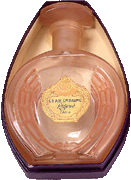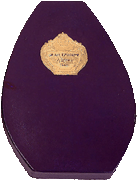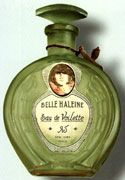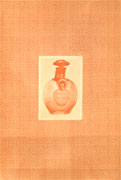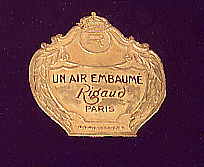“There are many people who may have contemplated the treasures of the Morgan Library without ever meeting personally its erstwhile director, Belle da Costa Greene. But no one there could have been unaware of her taste, her intelligence, her dynamism. For it was Miss Greene who transformed a rich man’s casually built collection into one that ranks with the greatest in the world.”
Aline B. Louchheim
New York Times, April 17, 1949
“Duchamp was apparently paid by the Morgan Library through Belle Greene, and this somewhat unusual arrangement took care of his financial needs for the next two years.”
Calvin Tomkins
Marcel Duchamp, A Biography, p. 155
click to enlarge

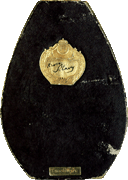
Illustration 1
Marcel Duchamp,Belle Haleine: Eau de voilette, 1921
© 2000 Succession Marcel Duchamp ARS, N.Y./ADAGP, Paris
The sound of Belle Greene’s name brings to mind a recent unpublished fact about Duchamp’s Belle Haleine: Eau de Voilette(1921), an assisted readymade using a Rigaud perfume bottle with an altered label. The label features a Man Ray photograph of Duchamp dressed as a woman. It reads “Belle Haleine: Eau de Voilette” [Beautiful Breath, Veil Water], and Duchamp signed the accompanying perfume box “Rrose Sélavy.”(See Illustration 1)
Recently, Rhonda Roland Shearer discovered that Duchamp altered the perfume bottle,(1)by changing the bottle’s original peach color to green — and it is important to note that peach was the only color ever used for Un Air Embaumé, the particular Rigaud perfume that Duchamp appropriated. (See Illustrations 2A of the standard Rigaud bottle color with box. In illustration 2B, the tint has been washed off a Rigaud bottle with water, leaving clear glass.
click images to enlarge

Illustration 2
Rigaud perfume bottle
(before wash off)
Illustration 2A
Box for Rigaud perfume bottle
Illustration 2B
Clear glass Rigaud bottle after washing
with water (Note: Rigaud changed the box and bottle label in later
designs but still kept the peach tinted bottle.)
Shearer notes, “By looking carefully at Duchamp’s green bottle, one will see peach color remaining in the cracks at the bottle’s bottom.”) Furthermore, Shearer noticed that Duchamp depicted the color of his green bottle as red in New York Dada (1921) and that the bottle later appears in the original peach color in The Box in a Valise (1941). (See Illustrations 3A, B, and C)
Duchamp changed the color of the perfume bottle, a fact that no one noticed even after it was first exhibited in 1965. (2) In addition, any degree of underlying meaning or ironic suggestion intended
by passing a common readymade peach-colored bottle for green likewise remained unknown. What new relationships could emerge when considering this new information of Duchamp’s green colored bottle actually having a peach past?
click images to enlarge

Illustration 3A
Marcel Duchamp,Belle
Haleine: Eau de voilette, 1921
© 2000 Succession Marcel Duchamp
ARS, N.Y./ADAGP, Paris
Illustration 3B
Marcel Duchamp, Cover for
“New York Dada”, 1921
© 2000 Succession Marcel Duchamp
ARS, N.Y./ADAGP, Paris
Illustration 3C
Marcel Duchamp, Original peach from
The Box in a Valise, 1941
© 2000 Succession Marcel Duchamp
ARS, N.Y./ADAGP, Paris
While reading a short passage about Belle da Costa Greene and Duchamp, I began combining this new information with Duchamp’s propensity to play with sounds and meaning. (3) The action of dying the bottle and the resulting color was, for me, a path to Belle Greene: Bottle Dye Color
Green, Belle Da Costa Greene. My curiosity was piqued. I wondered if Belle da Costa Greene was Duchamp’s inspiration for the mysterious artwork Belle Haleine.
click to enlarge

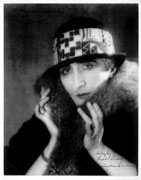
Illustration 4A
Marcel Duchamp,Marcel duchamp
as Belle Haleine, 1921
© 2000 Succession Marcel Duchamp
ARS, N.Y./ADAGP, Paris
Illustration 4B
Marcel Duchamp,Marcel duchamp
as Rrose Sèlavy, 1921
© 2000 Succession Marcel Duchamp
ARS, N.Y./ADAGP, Paris
Duchamp signs this work “Rrose Sélavy.” Yet the picture of Duchamp dressed as a woman on the perfume bottle label that he designed and printed is distinctly different from later photographs of Duchamp passing as Rrose. (See Illustrations 4A and B depicting the two Rrose Sélavy versions.) Perhaps Duchamp was passing as Rrose passing as Belle Haleine passing as Belle Greene. That is, did the photograph on the label contain clues that pertained to Belle Greene? Duchamp draws our focus to the letter ‘r’ as it is the only letter he draws in mirror reverse. (See Illustration 5).
Moreover,
click to enlarge
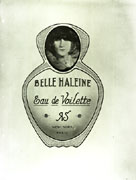
Illustration 5
Marcel Duchamp,Label forBelle
Haleine: Eau de voilette,1921
©2000 Succession Marcel Duchamp
ARS, N.Y./ADAGP, Paris
Moreover,our attention is further directed to the letter ‘r’ because it is one of the first times, here on this Belle Haleine work, that Duchamp signs Rose as Rrose, adding a second ‘r’.(4) Would this change in spelling, and the addition of a second ‘r’, also relate to Belle Greene?
First, who was Belle da Costa Greene? (see Illustration 6) Belle Greene became J.P. Morgan’s librarian in 1905, and following his death she became the director of his library, working there for a total of forty-three years. Empowered by J.P. Morgan, and then by his son Jack, Greene spent millions of dollars buying and selling rare manuscripts, books and art.
click to enlarge
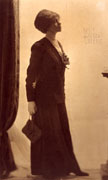
Illustration 6
Photograph of Belle de Costa Greene
by Clarence White, 1911 © Archives of
the Pierpont Morgan Library,New York.
She traveled frequently and lavishly to Europe, staying at the best hotels — Claridge’s in London and the Ritz in Paris. It was even said that “on trips abroad, made on Morgan’s behalf, she would take along her thoroughbred horse, which she rode in Hyde Park.” (5) Belle Greene was described as beautiful, sensual, smart and outspoken. (Illustration 6) One author writes that “she daringly posed nude for drawings and enjoyed a Bohemian freedom.” (6) Never married, she favored affairs with rich or influential men, with a focus on art scholars. Another scholar states, “her role at the Morgan Library placed her at the center of the art trade and her friendship was coveted by every dealer.” (7)For many years, Belle Greene wielded an astounding amount of power in the art world and moved comfortably in elite social circles.
One piece of information draws an amazing parallel between Belle Greene and the color change of Duchamp’s Belle Haleine bottle. Belle Greene was a black woman who denied her color to pass herself as white. (8) Evidence indicates that whispers and rumors about her passing circulated around her throughout her life. People like Isabella Gardner, society patron of the arts with close ties to Harvard and a peer of Morgan’s, wrote that Belle Greene was a “half-breed” in a private letter (1909) to Bernard Berenson and his wife, Mary, saying, “But first you must both swear secrecy. If not, please do not read anymore of this.” (9)
Bernard Berenson, a Harvard-trained art historian, also Belle Greene’s lover and later a friend for many years, reportedly said to his next paramour that Greene was “handicapped only by her part-Negro inheritance.” (10) (As so often happens, sworn secrecy is no match for the seduction of perpetuating rumor.) Cleve Gray, translator for Duchamp’s mathematical notes and close friend of Duchamp’s brother Villon, reports that when he was a student at Princeton he visited the Morgan Library, met Belle Greene, and was aware of the rumors.(11)(Cleve Gray, being a Princeton man, was an exception, as everyone in Belle Greene’s circle seemed to be Harvard men, including Morgan himself.) Apparently, these rumors persisted even after Greene’s death. Jean Strouse’s richly-detailed, well-researched biography of Morgan is the first published account of Belle Greene that throughly investigates her background. These rumors eventually served as successful guides for Ms. Strouse’s research.(12)
click to enlarge
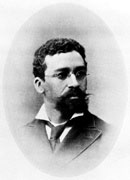
Illustration 7
Richard Theodore Greener
In order to pass, Greene and her mother decided to change their name. (Actually, you could say that they altered their label.) They added “da Costa,” claiming to be part-Portuguese to account for their dusky appearance, a common strategy used for passing. True to the rumors, not only were they black passing for white, but Belle Greene’s father was the distinguished lawyer and public figure, Richard Theodore Greener, the first black undergraduate to receive a degree from Harvard.(13) (See Illustration 7) Jean Strouse writes that in an issue of the Harvard alumni news, Greener and his daughter, Belle Marion, are both mentioned. Obviously, being the first black graduate of Harvard would draw a lot of attention, especially since he worked in politics and wrote on controversial issues such as Irish rights. After he retired and settled in Chicago in 1908, he continued to write on these topics and was a member of the Harvard Club. (The Harvard connection for Duchamp began with Walter Arensberg, a Harvard graduate who was Duchamp’s host when he first arrived in New York in 1915. Arensburg immediately included Duchamp in a group of Harvard alumni chess players and soon became his great patron.) (14)
In order to further distance themselves from the famous African American Richard Greener, Belle and her mother dropped the ‘r’ from their last name. (15) When passing for a woman, Duchamp absurdly adds an ‘r’ to become Rrose Sélavy, whereas for Belle Greener, to pass as a white, she drops the ‘r’from Greener. Is there a connection?
In 1921, Duchamp chose to change the spelling of Rose Sélavy to Rrose Sélavy, resulting in our attention being drawn not only to the added ‘r’ but also to the act and idea of an absurd change in spelling itself. (16)
Fundamentally, the choice of adding or subtracting the ‘r’ of her last name was the critical move that determined whether or not Greene lived in a white (Belle Greene) or a black (Belle Greener) world.
A summary of the factual analogies and reversals connecting Duchamp’s Belle Haleine to Belle Greene are as follows:
· Duchamp is a man passing as a woman.
· Belle Greene is a black woman passing as white.
· The commonly-sold Rigaud peach-colored bottle is passing as green-colored.
· Belle’s lover, Bernard Berenson, was (famously) a Jew passing as a Christian(17)
· Belle Greener dropped the last letter — an ‘r’ — of her name (a label), whereas, Duchamp, as Rose Sélavy, absurdly adds a first letter — an ‘r’– to her label.
click to enlarge
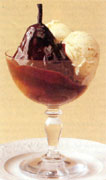
Illustration 8
PearBelle-Hélène
Looking at the full title of this work, Belle Haleine: Eau de Voilette, more connections emerge. If we combine literal translations and the sound of the title, we get Eau de Voilette, which means “veiled waters.” “Da Costa” also means “the coast” (along the water). In effect, Belle used da Costa, the coast along the water, to veil, mask or conceal her identity. Belle Haleine also sounds like Belle Hélène, the classic French dessert whose basic ingredient is a chocolate-covered pear..(18) (See Illustration 8) A chocolate-covered, shapely pear reflects an image of “the beautiful slim-waisted sensual figure”(19)of Belle Greene. To our list of analogies and reversals, we can add a peeled, white pear (previously green-skinned) passing as chocolate. Belle Hélène, the dessert, works now in reverse, a white (pear) passing for black (chocolate), or if you prefer, a pair (Belle Greene and a pear) both dipped in chocolate.
As previously mentioned, we see an image of Duchamp dressed as Rrose Sélavy on the label of the perfume bottle. The box for the perfume carries her signature. The difference between the Belle Haleine version of Rrose Sélavy and later ones is striking (for comparison, see the Man Ray photographs previously illustrated). Rrose Sélavy (on Belle Haleine) wears what looks like pearls, a fancy hat, a grand collar on her dress, lots of make-up and a haunting, stern look. Pearls, in 1921,were a very expensive status symbol. Beautiful pearls were five to ten times more expensive than they are today. The pearls, the hat, the look of this Rrose on the label of Belle Haleine reflect wealth. The second version of Rrose, depicted in the Man Ray portraits, has a contemporary, youthful hat, no pearls, a coat with a coquettish fur collar and similarly coquettish facial expression. (Duchamp inscribed a note on one of the photographs of this second version of Rrose, “Hat and hands [belong to], Germaine Everling.” (20) See again previous illustrations). The second Rrose is much younger and more casual than the first society lady Rrose Sélavy.
click to enlarge
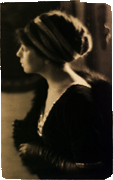
Illustration 9
Belle Greene with Pearls
The Rrose in Belle Haleine certainly seems to approximate the style and look of Belle Greene. The report of her stating, “just because I am a librarian doesn’t mean I have to dress like one,”(21)
did not prepare me for the descriptions of Greene at work. One scholar writes, “glamorous and heavily-perfumed, and dressed in Renaissance gowns adorned with matching jewels.”(22)Another writer states, “she always carried a large green silk handkerchief that she used for dramatic effect.”(23) Apparently Greene liked pearls, too. The author of The Book of the Pearl (1908) inscribed a copy to Belle Greene. (See Illustration 9) (24) More importantly, she was photographed wearing her long pearl necklace.(25)
click to enlarge
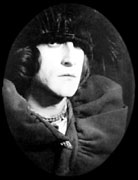
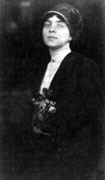
Illustration 10
Marcel Duchamp,Marcel duchamp
as Belle Haleine, 1921
© 2000 Succession Marcel Duchamp ARS,
N.Y./ADAGP, Paris
Illustration 11
Photograph of Belle de Costa
Greene,1911
She obviously dressed to accentuate her power, glamour and access to wealth through her femininity. At other times it is reported that Belle dressed to express her power and access to wealth in a surprisingly opposite masculine style. “She would stride about in a tweed suit, throwing colorful remarks offhand over her shoulder. Or, with her jacket removed she would stand belligerently while she talked with you…” (26) (Imagine what ‘standing belligerently’ might look like and consider the severe facial expression of Rrose on the label of Belle Haleine.)(See Illustrations 10 and 11)
There is some uncertainty over which art object Duchamp first signed with the double ‘r’ (Rrose). It may have been on the perfume bottle box or on a painting Picabia invited many artists to sign, L’oeil cacodylate (1921), a Dada collaboration. However, scholars agree that the Rrose Sélavy with the extra ‘r’ was first published in Le Pilhaou-Thibaou (July 10th, 1921), the illustrated supplement of Francis Picabia’s Dada magazine 391. (See Illustration 12, Duchamp’s pun as it appeared in Le Pilhaou-Thibaou) Rrose’s signature appeared under a pun that Duchamp had originally sent to Picabia from New York, in an undated letter of January, 1921.(27)
click to enlarge
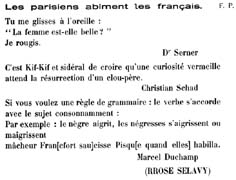
Illustration 12
Marcel Duchamp, Pun from Le Pilhaou-Thibaou
(illustrated supplement of 391), 1921
Rrose writes:
Si vous voulez une règle de grammaire: le verbe s’accorde avec le sujet consonnament: Par exemple: le nègre aigrit, les négresses s’aigrissent ou maigrissent.(28)
[“If you want a rule of grammar: The verb agrees with the subject consonantly: For Example: the Negro embitters, the Negresses become embittered and thin.”]
Significantly, we can interpret this pun as describing Belle Greene’s and her mother’s relationship to Richard Greener. The black man (Greener) has caused the black women (Belle and her mother, the former Mrs. Greener) to become hostile (bitter) and their name without the ‘r’ (thinner). See Stephen Jay Gould’s informative discussion about the relationship of this pun to Belle Greene in the text box below.
Linking Belle Greene to Duchamp’s Rule of Grammar
Stephen Jay Gould
My analysis may be judged largely conjectural here, but if the 1921 Negro pun also refers to Belle Greene’s passing, and to the dropping of the final “r” from her name, then the conjunction in meaning between this verbal play and the visual creation of Belle Haleinebecomes truly striking — and (presumably) expresses Duchamp’s anger and bitterness arising from the shame of his rejection (at least as a patron, and perhaps as more than just a friend) by this fascinating woman. Duchamp wrote to Picabia at the most relevant time of January, 1921 (and later published the statement in July of 1921), virtually contemporaneously with the Belle Haleine bottle:
Si vous voulez une règle de grammaire: le verbe s’accorde avec le sujet consonnament: Par exemple: le nègre aigrit, les négresses s’aigrissent ou maigrissent.
This pun has puzzled many people, for the point seems so lame (see André Gervais’s La raie alitée d’effets, p. 41 et seq.) In translation, the statement says “If you want a rule of grammar: the verb accords with the subject consonantly: for example, the Negro embitters, the Negresses become embittered and get thin.” So what’s the big deal about consonance? Yes, when you feminize and pluralize the word for a single black male (nègre), obtaining négresses, then the near rhyme with the appended verb is preserved: nègre and aigritchanges to négresses and s’aigrissent or maigrissent. But so what? Pluralizations of nouns and verbs often yield such consonance in both grammar and sound in French. Duchamp must have had more in mind.
But now suppose that Duchamp knows the rumors of Belle Greene’s passing –that to do so, she changed her father’s name Greener by dropping an “r” and becoming Greene, thus hoping to break the familial tie and be able to pass as a white woman. Now the pun achieves a complex and truly pungent meaning (if not downright nasty for anyone who knew the full context). Take out the comma and read “les négresses” as both the object of “le nègre” and as the subject for the next part. We now get for the first part: “The black male embitters the black women” — as Richard Greener did for Belle and her mother, both of whom wished to pass for white, but could not do so if the tie to Greener were known, therefore poisoning their plan. The second part then reads: “The black women become embittered and get thinner.” Even more incisive. Belle and her mother become bitter about the limitations imposed by their racial affiliation (and what a comment on the evils of the far more racist American society of the 1920’s), and they get thinner — wasting away from the bitterness perhaps, but probably also a wry comment on their strategy of distancing themselves from Greener by dropping the final “r” from their name to achieve a new, and literally thinner, identity.
So far so good. This part seems sound to me. Let me now be a bit more conjectural about the first line. (If even some of this speculation holds, then Duchamp’s pun becomes truly deep and almost diabolical). “Une règle de grammaire.” Yes, a grammatical rule but also, with almost the same pronunciation, “une règle de grandmère” — or “grandmother’s rule,” perhaps a statement on the ineluctability of racial heritage. We then continue: “le verbe s’accorde…” “Verbe” is a near homonym of “vert,” meaning “green” in French. Even more incisively, “verbe” could be a contraction for “verte Belle” or “green Belle.” “Verte Belle is a near homonym of “verbal” — so Duchamp might be indicating a “verbal accord” with the subject. The subject of the pun sentence is “Le nègre.” So green Belle, trying to pass for white, cannot escape the accord with her black father, the subject of the pun. Moreover, “nègre” just happens to be an anagram of “green”!
Now consider “s’accorde”: Inoffensively, in French, the word just means “agrees” (third person singular of the reflexive verb s’accorder, to agree or harmonize with). But, as a pun, “s’accorde” could also be “sa corde” — that is “her rope,” or metaphorically her burden. (“Corde” is masculine, so proper grammar would read “son corde,” but sexual gendering of inanimate objects should not be allowed to destroy a pun). So we now have “le verbe s’accorde,” or “green Belle, her rope.” But we can also glimpse the solution actually taken by Ms. Greene. Drop the “r” from s’accorde (as Belle dropped the “r” from her name to distance herself from her black father), — and we get “s’accode” or, punningly, “sa code.” In French, code is also masculine and should be “son code” — but the meaning could not be more incisive: her code! (Perhaps Duchamp even valued the grammatically false gendering, for the rope and the code, while grammatically masculine, apply here to a woman — so why not make them feminine)?
click to enlarge

Illustration 13
Coffin-like Rigaud box for Un Air Embaumé
perfume (Note: Rigaud changed the box
and bottle label in later designs but
still kept the original shape of the box.)
The Un Air Embaumé Rigaud label text and box reminded Shearer of Duchamp’s emphasis on the death and mausoleum storage of art in museums, with its coffin-like box shape and the alternative reading of Embaumé as “embalmed.” (See illustration 14 the Rigaud box coffin-like appearance) Shearer offers that perhaps Duchamp wanted to preserve (as Egyptions use perfumes to embalm) Belle Greene’s lie for posterity. (29)
Gould writes more on Un Air Embaumé Rigaud punning. See text box below.
From the Bitter Negro Pun to the Beautiful Breath Bottle
Stephen Jay Gould
The case for viewing Duchamp’s Belle Haleine bottle as an ironic commentary upon his feelings for Belle Greene and her efforts, as a light-skinned African American, to pass for white gains great strength, as Bonnie Garner has shown, by linking the otherwise lame 1921 “Negro pun” to Belle Haleine. Even though uncertainty surrounds the timing of Duchamp’s signature for Rrose (with the double R) Sélavy on the box of Belle Haleine, scholars agree that Duchamp used the double R for the first time when he wrote the Negro pun. (The double R represents an important argument in Garner’s case because, in her effort to pass, Belle Greene dropped the final “r” of her famous father’s name, Richard Greener, the first African American graduate from Harvard. Note also that scholars have, for years, debated the origin and meaning of the double R, and have compiled a long list of disparate theories. Ms. Garner may now have found a much simpler and more satisfactory basic explanation).
The full case would become even stronger if we could link the 1921 pun to the 1921 bottle by more than the common subject of their final outcome. I believe that a persuasive, albeit unproven, argument can be made for such a connection.
How did Duchamp get his idea to alter a perfume bottle, and why did he choose his particular substrate for Belle Haleine? The answer may lie in Duchamp’s affinity for punning. We know that the original bottle held a brand of perfume manufactured by the Rigaud company and called Un air embaumé (literally, perfumed air). But the verb embaumer means either to perfume or to embalm (an obvious commonality of process despite the different purposes). Moreover, in French, the word air and the name of the letter “r” have exactly the same pronunciation — and we know that Duchamp loved, and frequently created, puns based on different meanings for the names and sound values of letters (with LHOOQ as a primary example, but see my general discussion in my article, in this issue on “Duchamp’s Substantial Ghost“).
Thus, “un air embaumé” becomes a perfect homonymic pun meaning either “perfumed air” (as Rigaud intended) or “an embalmed r” as I suspect Duchamp recognized.
Could Duchamp have resisted such a temptation to alter the bottle for a second statement (following the Negro pun written a few months earlier) to “out” Belle Green by showing the world in concrete fashion — that is, by embalming so that it could not decay away, as Ms. Greene wished — the telltale missing r of her original name?
Moreover, and making the pun even more delicious, the verb rigolermeans “to laugh, have fun, or be joking,” and the derived adjective and noun rigo (masculine, rigote feminine) means “funny” or “odd” as an adjective, and (even more strikingly) a “wag” or a “phoney” as a noun. Rigo and the name of the perfume maker Rigaud have exactly the same pronunciation in French. So we have “an embalmed r” manufactured by a jokester or phoney. How could Duchamp not have used such a bottle to house his evil genie, a being cryptic enough not to blow Belle’s cover (for I doubt that Duchamp wished to destroy Belle, as the exposure of passing would certainly accomplish in the racist America of the time), but more than sufficient to make her squirm (though I doubt that she ever knew or suspected — or that the supremely arrogant Duchamp gave a damn whether she did or didn’t. He had made his point and achieved his personal revenge!)
In a purely technical sense, Bonnie Garner’s case remains circumstantial. But one reaches a point — achieved, I think, with the linkage of the Negro pun and the Belle Haleine bottle, and with the plethora of independent affirmations for each piece taken separately — when the cascade of independent items of confirmation, all pointing in the same direction, becomes so overwhelming that no other single explanation could possibly coordinate all the data. At this stage, we reach the style of confirmation — different from the usual mode of proof in science, but no less powerful — that William Whewell, the great 19th century British philosopher of science, called “consilience,” literally the “jumping together” of so many otherwise unconnected facts that the sole coordinating explanation becomes unavoidable. I believe that Ms. Garner has made her case by consilience, and that the burden of disproof must now lie with scholars who wish to deny the link of Belle Greene and her missing r both to the addition of the extra and initial r to Rrose Sélavy, and to the creation of Belle Haleine.
In addition, Duchamp would know Belle Greene to be caustic and hostile (“bitter” as in the pun) from both her reputation and from direct experience. Duchamp worked for Greene, although not for long. Her reputation then was for being mercurial in temper, demanding and, at times, ruthless. One man, who worked as an assistant director at the Morgan Library under Greene, said, “She (Belle) was a real tartar. You’d have to work under her to know it.“ (30)
click to enlarge

Illustration 14
The ship Duchamp would sail on to New
York in 1915
Before Duchamp sailed for America in 1915, on April 2, he wrote to his friend, Walter Pach, “I would willingly live in New York. But only on the condition that I could earn my living there. 1st. Do you think that I could easily find a job as a librarian or something analogous that would leave me great freedom to work (Some information about me: I do not speak English […] I worked for two years at the Bibliothèque Sainte-Geneviève as an intern)” (31)
click to enlarge

Illustration 15
Photograph of Marcel Duchamp, 1915
© 2000 Succession Marcel Duchamp ARS,
N.Y./ADAGP, Paris
After receiving this letter, Pach arranged for his father to provide a letter of introduction to Belle Greene so that Pach could see if Greene knew of any work for Duchamp. During the spring, she reported to Pach that she was unable to find any work anywhere for Duchamp. After Duchamp arrived, in the summer of 1915, Pach brought Duchamp to the French Institute. (Illustration 14 and 15 depicting the ship Duchamp sailed on and Duchamp’s appearence in 1915)Duchamp made friends with one of the workers who told Duchamp that they thought a position might open up and that Belle Greene would be in charge. Pach had just written to Quinn (another member of the Harvard (Law) circle) to ask his advice about his (Pach) approaching Greene again, or to see if it would be better if Quinn contact her himself. Duchamp next told Pach about the news that he had just learned about a possible job opening at the French Institute. The next day, Pach wrote to Quinn with the new information and made a direct request for Quinn to appeal to Greene on behalf of Duchamp.
Quinn then wrote to Greene, who agreed to meet with Duchamp at the Morgan Library. After the first meeting, Duchamp wrote Quinn that his hopes were surpassed as Greene said she would ask the president of the French Institute for part-time work at $100 per month (the equivalent today of about $1,600). The night of their first meeting, Greene wrote to Duchamp, who later shared this letter with Quinn and was in a happy mood. The following week Greene introduced Duchamp to Hawkes, president of the French Institute. All seemed to go well. Duchamp met with Greene the next day and together they went to the French Institute where she gave him provisional work. He was told that the position was temporary, pending the decision of a committee that was scheduled to meet in one month. Duchamp started work on the 14th of November, 1915. On the 18th Hawkes wrote to Greene. On the 26th Greene wrote a short, two-paragraph letter to Hawkes with an apology for her delay in answering him. Both paragraphs are about Duchamp, stating that he was not progressing as fast or as well as she hoped or desired and she very much feared that he would not suit their purpose. She ended the letter indicating that on the following day she would definitely determine whether or not to keep Duchamp. She concluded with a statement to the effect that she would bear the expense of the ‘try-out’ with Duchamp. (32)
Six weeks later, on January 12, 1916, Duchamp was let go by Greene. She paid him $60 for each month (not the hoped-for $100). Duchamp wrote to Quinn that Greene would write to him, as she instructed him to wait until he hears from her. After two weeks passed, Duchamp wrote Quinn to say that he had “not yet heard from Belle Greene.”(33) Greene had apparently handed Duchamp a “don’t call us, we’ll call you” firing and good-bye message.
click to enlarge

Illustration 16
Photograph of Marcel Duchamp,
© 2000 Succession Marcel Duchamp ARS,
N.Y./ADAGP, Paris
I suspect that this abrupt firing and brush-off was a humiliating experience for Duchamp. Both of his socially powerful friends, Pach and Quinn, had put great effort into securing this opportunity. Duchamp even wrote Quinn, on January 1st, that he liked the work and would write his intentions to Ms. Greene as suggested by his friend who worked there. Obviously Duchamp had a different view of himself and his work than the negative one painted by Greene in her letter to Hawkes.
Given the tone of Greene’s letter to Hawkes, it is probable that she and possibly Hawkes had the power to make the decision to hire or fire Duchamp, and it is likely that there never was a committee’s decision to wait upon, a fact that could be established by Duchamp’s contacts at the French Institute. Greene was known for her outspoken behavior and her indiscretion. Resulting rumors could only have embarrassed Duchamp further.
It is more than likely that Greene was aware of the fame around this young artist. Before beginning his work for her, Duchamp had appeared in five newspaper interviews. Since he had experienced notoriety in New York, he likely would have found Greene’s ill treatment beneath his status. After all, even his arrival in 1915 attracted the press — they were waiting for him at the dock! Young, handsome and charming, Duchamp clearly rode the wave of being the French artist of the Armory Show fame, but even so, Greene would have recognized, and been sensitive to, his lack of financial or academic substance. (34)
(See Illustration 16 of a nattily attired Duchamp in the country sometime during 1917) Greene, in her early 30s, was a liberated, independent, intelligent and beautiful woman with a focus and discrimination tuned to success. Although their art interests ran in different circles, there was overlap.Greene was a friend of Alfred Stieglitz and was invited to contribute an article to his famed magazine.
(35)(See text box “What does 291 mean to me?” by Belle da Costa Greene, Camera Works, January 1915).
What does “291” mean to me? – The thrills received from Matisse, from Picasso, from Brancusi? The Rabelaisian delights of Walkowitz, the glorious topsy-turvydom of Marin or the glowing sincerity of Steichen? In vain do I try to convince myself that all of this is “291” – quite in vain – “291” is Stieglitz. I can see you rage as you read this, dear Stieglitz.
I can see that wonderful hirsute adornment of yours rise as if under the machiavellian hand of De Zayas – but you are quite helpless, you cannot apply the blue pencil – the Censor has never yet ben admitted to “291.”
Yes, Stieglitz, in spite of your “art stuff” you are It. In spite of your endless drool you are the magnet of Life.
I wish that I were able to repay you for the countless times you have so lavishly poured courage into my soul, enthusiasm into my living, and clarity into my thinking; – for the countless times I have come to you a hopeless incoherent mass, my courage like so much wet tissue paper, my mind fringed by the seeming uselessness of things, and left you an optimistic, determined and directed Endeavor.
I owe you much, Stieglitz, perhaps more than do your Satellites, for they, at least have seen the Light – they know that Rembrandt, Leonardo, Raphael, Velasquez and the other old fogies are weak, flabby and hopelessly defunct; they know that the Metropolitan Museum is but a morgue and as such should be relegated to its proper place under ground – but I, oh Stieglitz, am still groping in darkness – my eyes are still unopened – and when you are not looking, I creep back to that same Morgue, and find there, as I have at “291”, the glory you radiate.
Stieglitz – I salute you.
BELLE GREENE
click to enlarge

Illustration 17
Belle Greene Bottled Green,
digital collage by Rhonda Roland
Shearer, 2000
Like Greene, Duchamp courted and was courted by the wealthy and powerful in art circles. So, each had his/her own sense of entitlement and perhaps confronting it in the other may have proved too much for both of them, or at least for Duchamp. If their personalities clashed, her criticism of his work at the Institute would be beside the point. However, what we do know is directly from letters by Greene, Quinn, Pach, and Duchamp. The bottom line resulting from the circumstances of Duchamp’s employment, strange as they may be (for example, why was Duchamp paid for his ‘trying-out period’ by Greene and not the French Institute? Moreover, why was Greene firing him at the Institute? How did she know, as soon as Duchamp began, that he would not ‘suit our purpose’? And why didn’t she want him there?), is that Duchamp was canned by Belle Greene. Perhaps my case now reveals that Duchamp, though he used restraint by not exhibiting the Belle Haleine bottle while Belle Greene was alive, had his private revenge for Belle da Costa Greene through his Belle bottle dyed green. (See Illustration 17)
Notes
 1.In November 1999, Shearer privately informed me of her unpublished discovery. See Rhonda Roland Shearer’s “Marcel Duchamp’s Impossible Bed,” part I and Part II for her general arguments about how the readymades are not readymade as Duchamp presents them or as scholars have believed. A letter that Duchamp wrote to his good friend and New York socialite Ettie Stettheimer, August 10, 1922, suggests that, on more than one occasion, he used green dye and hinted at Belle Green being connected to his Belle Haleine dye job. Duchamp writes: “a marvelous, raincoat-like, dark bottle green” . . . “I am waiting with impatience that you come to NY to show off Rrose Selavy in bottle green.” (From Ephemerides On or About Marcel Duchamp and Rrose Sélavy 1887-1968 by Jennifer Gough-Cooper and Jacques Caumont. Cambridge: MIT Press, 1993.)
1.In November 1999, Shearer privately informed me of her unpublished discovery. See Rhonda Roland Shearer’s “Marcel Duchamp’s Impossible Bed,” part I and Part II for her general arguments about how the readymades are not readymade as Duchamp presents them or as scholars have believed. A letter that Duchamp wrote to his good friend and New York socialite Ettie Stettheimer, August 10, 1922, suggests that, on more than one occasion, he used green dye and hinted at Belle Green being connected to his Belle Haleine dye job. Duchamp writes: “a marvelous, raincoat-like, dark bottle green” . . . “I am waiting with impatience that you come to NY to show off Rrose Selavy in bottle green.” (From Ephemerides On or About Marcel Duchamp and Rrose Sélavy 1887-1968 by Jennifer Gough-Cooper and Jacques Caumont. Cambridge: MIT Press, 1993.)
 2. Duchamp waited to exhibit the green bottle of Belle Haleine until the 1965 exhibition, Not seen &/or Less Seen of/by Marcel Duchamp/Rrose Sélavy 1904-1964 at the Cordier & Ekstrom Gallery, New York (January 14-Febuary 13, 1965). Before 1965, only the New York Dada (1921) image of Belle Haleine in red, the Boîte-en-Valise version (1941) in peach, and the Man Ray photograph of the label were exhibited.
2. Duchamp waited to exhibit the green bottle of Belle Haleine until the 1965 exhibition, Not seen &/or Less Seen of/by Marcel Duchamp/Rrose Sélavy 1904-1964 at the Cordier & Ekstrom Gallery, New York (January 14-Febuary 13, 1965). Before 1965, only the New York Dada (1921) image of Belle Haleine in red, the Boîte-en-Valise version (1941) in peach, and the Man Ray photograph of the label were exhibited.
 3. Tomkins, Calvin. Duchamp, A Biography. (New York: Henry Holt and Company, 1996), 154-155.
3. Tomkins, Calvin. Duchamp, A Biography. (New York: Henry Holt and Company, 1996), 154-155.
 4. In his Marcel Duchamp: The Art of Making Art in the Age of Mechanical Reproduction (Ghent, Amsterdam: Ludion Press, 1999), Francis M. Naumann questions the time of the work’s signature (p. 94, note 49). In an e-mail to Thomas Girst of 2 April 2000 Naumann writes that he is now inclined to accept Duchamp’s stated version of when the work was signed. Arturo Schwarz reports in a fax to Rhonda Roland Shearer (4 April 2000) that Duchamp told him that he signed the label on the box of Belle Haleine after 1945.
4. In his Marcel Duchamp: The Art of Making Art in the Age of Mechanical Reproduction (Ghent, Amsterdam: Ludion Press, 1999), Francis M. Naumann questions the time of the work’s signature (p. 94, note 49). In an e-mail to Thomas Girst of 2 April 2000 Naumann writes that he is now inclined to accept Duchamp’s stated version of when the work was signed. Arturo Schwarz reports in a fax to Rhonda Roland Shearer (4 April 2000) that Duchamp told him that he signed the label on the box of Belle Haleine after 1945.
 5. Casfield, Cass. The Incredible Pierpont Morgan, Financier & Art Collector. (New York: Harper & Row, 1974), 152. Although this statement is published, this may be part of the myth surrounding Belle Greene. In a conversation with Jean Strouse, she said she found nothing in her research to support this statement. In keeping with both Greene’s ability to develop and live with a myth (and her sense of humor), I suspect that if this “horse story” is not true, Greene might have enjoyed perpetuating or possibly originating such a prestige-evoking story of wealth.
5. Casfield, Cass. The Incredible Pierpont Morgan, Financier & Art Collector. (New York: Harper & Row, 1974), 152. Although this statement is published, this may be part of the myth surrounding Belle Greene. In a conversation with Jean Strouse, she said she found nothing in her research to support this statement. In keeping with both Greene’s ability to develop and live with a myth (and her sense of humor), I suspect that if this “horse story” is not true, Greene might have enjoyed perpetuating or possibly originating such a prestige-evoking story of wealth.
 6. Chernow, Ron. The House of Morgan. (New York: Simon & Schuster, 1990),117.
6. Chernow, Ron. The House of Morgan. (New York: Simon & Schuster, 1990),117.
 7. Samuels, Earnest. Bernard Berenson, The Making of a Legend. (Cambridge: Harvard University Press, 1987), 286.
7. Samuels, Earnest. Bernard Berenson, The Making of a Legend. (Cambridge: Harvard University Press, 1987), 286.
 8. Strouse, Jean. Morgan, American Financier. (New York: Random House, 1999). This book contains a detailed and fascinating account of Belle Greene.
8. Strouse, Jean. Morgan, American Financier. (New York: Random House, 1999). This book contains a detailed and fascinating account of Belle Greene.
 9. Letter dated December 18, 1909. Strachey, Barbara and Jayne Samuels, eds. The Letters of Bernard Berenson and Isabella Stewart Gardner, 1887-1924. (New York: Harper & Row, 1974), 462.
9. Letter dated December 18, 1909. Strachey, Barbara and Jayne Samuels, eds. The Letters of Bernard Berenson and Isabella Stewart Gardner, 1887-1924. (New York: Harper & Row, 1974), 462.
 10. Secrest, Meryle. Being Bernard Berenson, A Biography. (New York: Holt, Rinehart and Winston, 1979), 249.
10. Secrest, Meryle. Being Bernard Berenson, A Biography. (New York: Holt, Rinehart and Winston, 1979), 249.
 11. As per private conversation, January, 2000, Ms. Shearer relayed to me what Cleve Grey told her in a personal conversation.
11. As per private conversation, January, 2000, Ms. Shearer relayed to me what Cleve Grey told her in a personal conversation.
Belle Greene herself was well aware of the rumors, excerpts from a letter written by Belle Greene to Bernard Berenson in 1912: “I really had to laugh at your last letter complaining of all the scandal you were hearing about me—I suppose they say everything…but what difference does it make?….I’ve come to the conclusion that I really must be grudgingly admitted the most interesting person in New York, for it is all they seem to talk about—C’est a rire—You know perfectly well BB…that I get “hipped” on some man, regularly every six months and I suppose it will be so until I die—but I get over it all so very quickly that it does not really disturb the actual current of my life at all—and BB….these men and this talk and all is so stupidly unimportant and irreverent—the only time I was really ‘scandalous’ was in your own dear company so if I guarantee that I will be really wicked only with you isn’t it alright?…” (Morgan, American Financier, Jean Strouse. page 520.)
 12. Strouse, Jean “The Unknown JP Morgan” in The New Yorker (March 29, 1999).
12. Strouse, Jean “The Unknown JP Morgan” in The New Yorker (March 29, 1999).
 13. Strouse, Jean. Morgan, American Financier, 512.
13. Strouse, Jean. Morgan, American Financier, 512.
Greener wrote a series called “The White Problem” and it was published in “The Cleveland Gazette” from the “St. Joseph’s Advocate” in 1894. The title ‘The White Problem’ is magnificently provocative. In 1906, in Washington, DC, Greener spoke before the literary society of the Metropolitan AME church. An article appeared in the Cleveland Journal, subtitled ‘Former Consul Greener speaks in Washington-Russian Jew can enjoy citizenship’. It may have appeared elsewhere. In November, 1920, an article titled ‘GREENER!’ appeared in the Union Newspaper. It discusses Greener’s education (1st from Harvard) and his career. It mentions that as a “bibliophile, he stands without a peer.”
 14. It is interesting to note that Duchamp was a frequent guest of the Stettheimer sisters. (It is to Floriene Stettheimer that Duchamp wrote his hint of ‘Rrose in bottle green’ mentioned in note 1) along with Carl Van Vechten, and his wife, actress Fania Marinoff. The Van Vechten’s promoted black performers and writers and knew the obstacles prejudice placed before them. (In fact, he was friend as well a literary sponsors of Nella Larsen and she dedicated her acclaimed novel Passing to the Van Vechtens.) Emily Farnham. Charles Demuth, Behind a Laughing Mask University of Oklahoma Press: Norman, Oklahoma. 1971.
14. It is interesting to note that Duchamp was a frequent guest of the Stettheimer sisters. (It is to Floriene Stettheimer that Duchamp wrote his hint of ‘Rrose in bottle green’ mentioned in note 1) along with Carl Van Vechten, and his wife, actress Fania Marinoff. The Van Vechten’s promoted black performers and writers and knew the obstacles prejudice placed before them. (In fact, he was friend as well a literary sponsors of Nella Larsen and she dedicated her acclaimed novel Passing to the Van Vechtens.) Emily Farnham. Charles Demuth, Behind a Laughing Mask University of Oklahoma Press: Norman, Oklahoma. 1971.
 15. Strouse, Jean. Morgan, American Financier, 512.
15. Strouse, Jean. Morgan, American Financier, 512.
 16. To explain the why, where and when of the added ‘r’, Duchamp offers us the same explanation in Dialogues with Duchamp (New York: Da Capo Press, 1971), an interview by Pierre Cabanne, that he states in another interview with Katherine Kuh in 1949 (Katharine Kuh. The Artist’s Voice: Talks with Seventeen Artists. New York: Harper & Row, 1962). In essence, Duchamp explains that when he was about to sign Picabia’s L’Oeil Cacadylate (1921) he was inspired by the double ‘r’ in the word arrose. In addition, he said to Katharine Kuh that he, “thought it clever to begin a word, a name with two ‘r’s like two ‘ll’s in Lloyd.” To Cabanne, Duchamp ends the same story with, “All of this was word play.”
16. To explain the why, where and when of the added ‘r’, Duchamp offers us the same explanation in Dialogues with Duchamp (New York: Da Capo Press, 1971), an interview by Pierre Cabanne, that he states in another interview with Katherine Kuh in 1949 (Katharine Kuh. The Artist’s Voice: Talks with Seventeen Artists. New York: Harper & Row, 1962). In essence, Duchamp explains that when he was about to sign Picabia’s L’Oeil Cacadylate (1921) he was inspired by the double ‘r’ in the word arrose. In addition, he said to Katharine Kuh that he, “thought it clever to begin a word, a name with two ‘r’s like two ‘ll’s in Lloyd.” To Cabanne, Duchamp ends the same story with, “All of this was word play.”
 17. I include Berenson in this list for a few reasons. Berenson would hold a place of special interest for Duchamp. It was through connections provided by Berenson that Duchamp’s brother, Jacques Villon got caught making forged Constables (and narrowly escaped big trouble). From 1899 to 1902, Villon was known as a “speed Constable painter.” He apparently provided forgeries for a friend, an art dealer and a man named Van Kopp. (See Simpson, Colon. Artful Partners. New York: Macmillan Publishing Co., 1986.) Art authenticator and art historian Bernard Berenson would likely have remained a dubious character for Duchamp due to his connection to Van Kopp and his brother. (More on this subject by me in a forthcoming article.)
17. I include Berenson in this list for a few reasons. Berenson would hold a place of special interest for Duchamp. It was through connections provided by Berenson that Duchamp’s brother, Jacques Villon got caught making forged Constables (and narrowly escaped big trouble). From 1899 to 1902, Villon was known as a “speed Constable painter.” He apparently provided forgeries for a friend, an art dealer and a man named Van Kopp. (See Simpson, Colon. Artful Partners. New York: Macmillan Publishing Co., 1986.) Art authenticator and art historian Bernard Berenson would likely have remained a dubious character for Duchamp due to his connection to Van Kopp and his brother. (More on this subject by me in a forthcoming article.)
Berensons’s affair with Belle Greene (and their subsequent lifelong friendship) also stirred the rumor mill about Belle Greene. Berenson’s own public “act of passing” and its meaning in the context of his life and times is explored in an article by Meyer Schapiro, “Mr. Berenson’s Values,” in Encounter Magazine (January 16, 1961), which I recommend.
 18. Esscoffier, A. The Escoffier Cook Book. English translation by Guide Culinaire. Originally published in 1903. New York: Crown Publishers, 1973.
18. Esscoffier, A. The Escoffier Cook Book. English translation by Guide Culinaire. Originally published in 1903. New York: Crown Publishers, 1973.
 19. Secrest, Meryle. Being Bernard Berenson, A Biography. (New York: Random House, 1979), 290.
19. Secrest, Meryle. Being Bernard Berenson, A Biography. (New York: Random House, 1979), 290.
 20. Schwarz, Arturo. The Complete Works of Marcel Duchamp, Volume Two. (New York: Delano Greenidge, 1997), 693.
20. Schwarz, Arturo. The Complete Works of Marcel Duchamp, Volume Two. (New York: Delano Greenidge, 1997), 693.
 21. Strouse, Jean. Morgan, American Financier, 510.
21. Strouse, Jean. Morgan, American Financier, 510.
 22. Casfield, Cass. The Incredible Pierpont Morgan, Financier & Art Collector, 152.
22. Casfield, Cass. The Incredible Pierpont Morgan, Financier & Art Collector, 152.
 23. Secrest, Meryle. Being Bernard Berenson, 290.
23. Secrest, Meryle. Being Bernard Berenson, 290.
 24. Kunz, George Frederick & Charles Hugh Stevenson. The Book of the Pearl: The History, Art, Science, and Industry of the Queen of Gems. New York: Century,1908.
24. Kunz, George Frederick & Charles Hugh Stevenson. The Book of the Pearl: The History, Art, Science, and Industry of the Queen of Gems. New York: Century,1908.
 25. A beautiful picture of Belle Greene with her pearls is featured in Jean Strouse’s article “The Unknown JP Morgan.”
25. A beautiful picture of Belle Greene with her pearls is featured in Jean Strouse’s article “The Unknown JP Morgan.”
 26. Auchincloss, Louis. J.P. Morgan. The Financier as Collector. (New York: Harry H. Arbam,1990), 19.
26. Auchincloss, Louis. J.P. Morgan. The Financier as Collector. (New York: Harry H. Arbam,1990), 19.
 27. Jennifer Gough-Cooper and Jacques Caumont, “Ephemerides on and about Marcel Duchamp and Rrose Sélavy,” (July 10, 1921,) in: Pontus Hulten (ed.), Marcel Duchamp: Work and Life, Cambridge: MIT, 1993.
27. Jennifer Gough-Cooper and Jacques Caumont, “Ephemerides on and about Marcel Duchamp and Rrose Sélavy,” (July 10, 1921,) in: Pontus Hulten (ed.), Marcel Duchamp: Work and Life, Cambridge: MIT, 1993.
 28. in: Le Philaou-Thibaou: Supplément Illustré de 391 (July 1921), n.p.
28. in: Le Philaou-Thibaou: Supplément Illustré de 391 (July 1921), n.p.
 29. It is interesting to note that Greene uses the phrase “the Metropolitan Museum is but a morgue” – a remark similar in nature to Duchamp’s philosophy – in a statement for Stieglitz’ Camera Works, January 1915.
29. It is interesting to note that Greene uses the phrase “the Metropolitan Museum is but a morgue” – a remark similar in nature to Duchamp’s philosophy – in a statement for Stieglitz’ Camera Works, January 1915.
 30. Secrest, Meryle. Being Bernard Berenson, 291.
30. Secrest, Meryle. Being Bernard Berenson, 291.
 31. Naumann, Francis M. “amicalement, Marcel: Fourteen Letters from Marcel Duchamp to Walter Pach,” in: Archives of American Art Journal (vol. 29, no. 3-4, 1989, pp.36-50) p. 39.
31. Naumann, Francis M. “amicalement, Marcel: Fourteen Letters from Marcel Duchamp to Walter Pach,” in: Archives of American Art Journal (vol. 29, no. 3-4, 1989, pp.36-50) p. 39.
 32. From the Pierpont Morgan Library Archives.
32. From the Pierpont Morgan Library Archives.
 33. New York Public Library, Manuscript and Archives Division: Quinn Letters. All dates and information are from letters in this archive. (Other sources for the Greene letter and Duchamp’s letter to Pach have been previously cited.)
33. New York Public Library, Manuscript and Archives Division: Quinn Letters. All dates and information are from letters in this archive. (Other sources for the Greene letter and Duchamp’s letter to Pach have been previously cited.)
 34. Senda reported to her brother Berenson that Belle said her that she did not wish to marry but if she did it would be for “money—much money.” (Bernard Berenson, The Making of a Legend, Ernest Samuels. page 119.) Apparently, Berenson was not rich enough for Belle Greene.
34. Senda reported to her brother Berenson that Belle said her that she did not wish to marry but if she did it would be for “money—much money.” (Bernard Berenson, The Making of a Legend, Ernest Samuels. page 119.) Apparently, Berenson was not rich enough for Belle Greene.
 35. Strouse, Jean. Morgan, American Financier. (New York: Random House, 1999)
35. Strouse, Jean. Morgan, American Financier. (New York: Random House, 1999)



